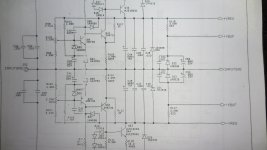I've been working on a Mark Levinson 27 which had mismatched but functional output transistors, slightly burned resistors (functional but brown), and out of spec electrolytic caps.
I've read many different views on tantalum caps, but have been advised that wet tantalums have many advantages over dry tantalums, and that they should be retained whenever possible.
There are two 68uF 25V wet tants in the ground portion of the regulator circuit. They measure about 40-50% higher, but have excellent ESR according to my meter.
Should I leave these in place, or replace them with electrolytics? The discussions about dry tantalums strongly lean towards replacement, but I'd like more guidance about these wet tants.
This is a really unpleasant amp to work on due to the construction and complexity; I really don't want to open it up again if these ever fail, or if being out of spec is an issue for this circuit.
Thank you.
I've read many different views on tantalum caps, but have been advised that wet tantalums have many advantages over dry tantalums, and that they should be retained whenever possible.
There are two 68uF 25V wet tants in the ground portion of the regulator circuit. They measure about 40-50% higher, but have excellent ESR according to my meter.
Should I leave these in place, or replace them with electrolytics? The discussions about dry tantalums strongly lean towards replacement, but I'd like more guidance about these wet tants.
This is a really unpleasant amp to work on due to the construction and complexity; I really don't want to open it up again if these ever fail, or if being out of spec is an issue for this circuit.
Thank you.
Attachments
I'd leave them in there, their charging rate is limited by the 3K resistor and they will never have a reverse voltage applied to them because of the 12V zener diode in parallel with them.They have had all the necessary precautions taken to prevent their failure. They will last longer and have lower ESR than any electrolytics that you replace them with. As with regards to their value, in that circuit more is better, but I doubt there would be much benefit.
Last edited:
If you have at hand a capacimeter, then I would take a couple of them arbitrarily, and measure them. If they are in the, say, ±10% then you can consider that they are OK and presumably the rest are also OK. If not, replace them with some of the same parameters.
When I measured them with my capacitance meter, they read 88-92uF.
Replacing these with current production wet tantalums will cost about $40 each - not in my budget.
Thank you for your input.
Replacing these with current production wet tantalums will cost about $40 each - not in my budget.
Thank you for your input.
Last edited:
The only POSSIBLE advantageous use of tantalum capacitors is as coupling caps in an old design, where indeed they may contribute to the unique "sound" of said circuit. As power supply bypass capacitors (such as you have shown), they are useless pieces of garbage just waiting to fail and cause damage.
I've not seen much evidence of wet slugs failing. They do need reforming sometimes after a long time unused. Is there anything published about their failure modes?
I think wet-slug tants are usually brass-cased, seals are glass, and the electrolyte is sulphuric acid. So failure should be pretty darn obvious/spectacular in terms of corrosion...
and no, I've not read of more subtle failure modes. If the ESR remains so good, I'd leave them; the actual value is less important. To replace like for like will be difficult to source & horridly-expensive; treated well, as these seem to be, likely have indefinite life. At least - I suspect these oldies might yet outlast 'cheap' electrolytic caps in equivalent values, put it that way.
and no, I've not read of more subtle failure modes. If the ESR remains so good, I'd leave them; the actual value is less important. To replace like for like will be difficult to source & horridly-expensive; treated well, as these seem to be, likely have indefinite life. At least - I suspect these oldies might yet outlast 'cheap' electrolytic caps in equivalent values, put it that way.
Last edited:
Wet tantalums have a pure silver case, and the electrolyte is gelled.
In addition, they can take a lot of abuse, meaning the chances of a spectacular failure are minimal, compared to other types.
In fact, I have never seen such a failure with this type. They sometimes fail, but in a more discreet way: a degradation of performances
In addition, they can take a lot of abuse, meaning the chances of a spectacular failure are minimal, compared to other types.
In fact, I have never seen such a failure with this type. They sometimes fail, but in a more discreet way: a degradation of performances
- Home
- Amplifiers
- Solid State
- Wet Tantalums - replace?
